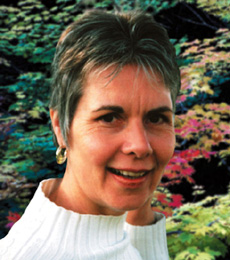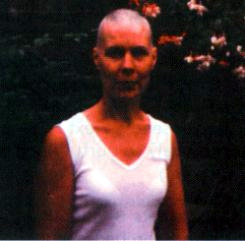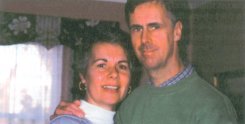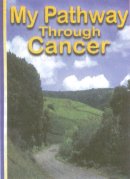CLICK HERE AND READ OUR BREAST CANCER OVERVIEW
Originally published in July 2003 icon
Breast Cancer - The Facts

Hazel Scade is enjoying a year of celebrations. It is three years since the former nurse stopped having standard medical treatment for breast cancer and started a "less-invasive" approach - and with her 50th birthday just months away she is looking and feeling great.
Taking the decision to stop chemotherapy, after her third course, and to adopt a more complementary approach - meant Hazel was able to enjoy family life and holidays with her husband Michael and teenage sons, Thomas and James, while getting well. She stresses, "the medical route is fine, if it suits you, but it didn’t suit me".
"Right now I feel wonderful. I often find it difficult to believe that I was diagnosed with breast cancer three years ago, and am glad I’ve got photographs and my diary to look back on to remind me what it was like.
I was a state registered nurse, until my local hospital closed in 1998, and I feel my background helped me because I know that doctors aren’t always right and that complications can follow after people have had straightforward surgery. My interest in complementary therapies also made me realise that the body can do a lot to heal itself.
It was doing reflexology massage on a new client, that first made me think I should go for a breast examination. On looking at her consultation form I noticed she had had breast cancer and followed the orthodox routine, lumpectomy, radiotherapy and chemotherapy. I can’t say I ever felt a lump but in my nursing career I was taught to look for inverted nipples and discharges. A few days later when I got out of the shower I thought my nipple seemed slightly inverted so I visited my GP. I was sure it wasn’t anything to worry about, but felt the need for some reassurance.
 Three days later I was given an appointment
Three days later I was given an appointment
On leaving the surgery my GP said, "Don’t be alarmed if the appointment comes through quickly, Hazel. They are very efficient in the breast clinic." Three days later I was given an appointment. The penny didn’t drop that I was obviously being reviewed as an urgent case. Following my doctor’s comments I just looked upon it as good management. The mammogram was an unpleasant experience. Then my name was called to see the consultant and as I entered the room I could see by the expressions of the consultant, the doctor, who was going to take a scan of my breast, and the radiographer that the news wasn’t good.
As I removed my gown, the consultant commented on the difference in the shape of my breasts. It appeared a lot more obvious to him than me. Without giving me a physical examination, he told me to lie down on the couch so that an ultra scan could be taken. He would then take a needle biopsy. I blurted out
I got off the couch in a state of shock, held on to his arm and asked not to be left alone for too long. The female radiographer kindly escorted me to a private room where she said I could remain until I felt ready to dress. I returned to my clothing and paced up and down the corridors letting the tears flood out, for what seemed like eternity. It would have been obvious that I was distressed, yet nobody offered assistance. Eventually a nurse found the time to take me to an office and help me contact my husband.
’It’s cancer isn’t it?’ My comment was confirmed and he added that we would have to wait for biopsy results so that he could be more precise with my diagnosis.
 You have got cancer, had been life-changing words
You have got cancer, had been life-changing words
It was such a relief to see Michael’s car appear, but as time was ticking by we were taken straight through to see the consultant without being able to converse between ourselves. The consultant confirmed that the sample taken from my right breast showed advanced breast cancer, and that treatment was required using chemotherapy and radiotherapy. I queried why surgery wasn’t mentioned and he replied that the cancer was too advanced for that. When I asked what would happen if I refused conventional treatment he said I would be dead within a year.
Michael was fully aware that my feelings had always been that if ever I should develop cancer I didn’t want to go along the conventional route, but when I was being told if I didn’t go ahead with the treatment I was going to die, I thought I had better do what they said, and try to do complementary things as well.
The next thing was to break the news to my two sons, Thomas and James, then aged 14 and 10. It was the first day of the Easter holiday so this was not at all pleasant and tears were shed. Michael and I then drove 90 miles to tell my parents. Following their reaction I felt so guilty at putting other people into a state of shock. I was used to giving comfort, and this change of role wasn’t me. ’You have got cancer,’ had been life-changing words.
Three days later we were at the oncology clinic, where my tumour was measured at 5.5cm x 4.5cm. The consultant explained that chemotherapy should be started as soon as possible and would last about five to six months. I could then go on to radiotherapy, after which surgery would be considered - a total mastectomy and the removal of lymph glands from both armpits.
 I could even sense people trying to weigh up if I really looked like a person with cancer
I could even sense people trying to weigh up if I really looked like a person with cancer
This was too much for me to take in. I could only take one step at a time and, because Michael and I had had time to discuss the matter, agreed to start chemotherapy. I asked if I would be allowed to receive nutritional therapy, acupuncture, reflexology and aromatherapy at the same time. He said these treatments would be of no harm and that some may well be of benefit.
I felt that being diagnosed with cancer was a symptom of a severely weakened immune system and that it was important to restore my ’whole self’ in order to destroy these cancer cells. My body had managed to prevent abnormal cells turning malignant for more than 40 years, so why couldn’t I get back into balance again? Would I be able to do this under the influence of powerful chemotherapy drugs?
Before Thomas and James returned to school I spoke to the staff and felt confident that both boys would be given the necessary support, if they needed it. ’Children need not be excluded from this emotional upheaval - they can understand more than many people give them credit for,’ states S. Lang & R. Patt in You Don’t Have to Suffer (1994).
Oncologists believe chemotherapy to be the most effective way of wiping out a large amount of cancer cells. This highly toxic fluid was injected into my veins. Just one drop would burn the skin, if it came into contact with it, and for this reason the nurse administering it wore gloves. I couldn’t help but ask myself, ’If such precautions need to be taken outside, what’s it doing to me inside?’ Nobody would talk much about the side effects, but even though I had taken some precautions against vomiting it started that night and was still with me 36 hours later. I couldn’t even keep down a sip of water! Michael saw my GP and got me a prescription for stronger anti-emetics to control the nausea.
As my treatment went on, my mother was very helpful and would come down with my father, every week, laden with prepared food. She had bought Healing Foods Cookbook from the Bristol Cancer Help Centre and prepared new recipes for me with many ingredients she had never heard of before.

Many other people didn’t know how to approach me, though. Embarrassment showed on their faces and they would even cross the road, pretending not to see me. I could even sense people trying to weigh up if I really looked like a person with cancer. I almost found it easier when my hair fell out - then people could see that there was something wrong with me.
My emotions would change from high to low - from euphoria, that I was alive and loved, to the dark pit of despair, when the side effects of treatment would remind me I had a serious illness. There were times I felt so down that if I knew I could go to sleep and never wake up I would have chosen to, because I was so drained. I think it was knowing that I was going to stop the chemotherapy and find another route that kept me going. That and my family’s love and care.
Two days before my second course of chemotherapy, a friend gave me some information about CAIB (the Cancer Alternative Information Bureau) that she’d taken from the internet. Two weeks later, on June 5 2000, Michael and I were listening to the different speakers at their seminar. This was definitely more like the path that I wanted to follow, and Michael agreed.
Three days later we went on the two-day introductory course at the Bristol Cancer Help Centre. It felt so nice to be in a haven of peace and tranquillity, and I met people who were able to lift my spirits. I had things I knew confirmed that meat and dairy products contain large amounts of synthetic oestrogens, which lead to oestrogen dominance - a cause of cancer - and learnt many things, including how to use visualisation.
I carried on doing it, at least three times a day, once I returned home. I would visualise my cancer as a nasty black mass of earth. A gardener would then appear with a fork, and work hard to break this mound into smaller pieces. Fertiliser and nutrients would be added, before planting flower seeds. Next I could see lovely colourful flowers growing.
I also spoke to a visiting doctor who had been working in oncology for many years. When I told her that I wanted to stop conventional treatment, she explained that a lot of research had taken place to find that three chemotherapy treatments were as effective as the standard six treatments given for my condition. On mulling this over, I thought it was probably worth the risk of receiving one more treatment. Maybe this would give some satisfaction that I had given standard treatment a chance as well.
 I would visualise my cancer as a nasty black mass of earth
I would visualise my cancer as a nasty black mass of earth
About 10 days later Michael drove me to Kent to see a doctor we’d heard about at the CAIB seminar. Dr Fritz Schellander gave me a thorough consultation, at the Liongate Clinic, lasting one and a half hours. Following examination he said that the cancer mass did not seem to be as bad as it appeared on the mammogram. If surgery was necessary he could refer me to somebody privately, whom he felt would show more consideration, because it did not appear that I needed such extensive surgery. A detailed letter with suggested treatment arrived the next day and we decided to go ahead with the three-day treatment.
Blood tests were taken and Fritz said that one of the tumour marker readings was slightly elevated and he ’would keep an eye on this’ I’m pleased that following my chosen treatment path these figures went down, indicating that the cancer was in remission. Fritz suggested that this test should be repeated occasionally, so that if the level should rise again it is an early indication that the cancer has either recurred in that area, spread to nearby lymph glands, or metastasised to another organ.
Local hyperthermia was chosen for me to receive daily whilst at the clinic. Hyperthermia is made up from the Greek words hyper, to raise, and therme, to heat. A statement from a medical paper by Dr TK Hei et al of the college of physicians, Columbia University (April 2 1986) states, ’Hyperthermia is the only agent to treat cancer that does not itself appear to be oncogenic (cancer inducing)...in contrast most chemotherapeutic agents used clinically at present are carcinogenic in their own right.’ The rationale behind me receiving this treatment was because cancer cells are more heat-sensitive than normal cells, they would be broken down under excessive heat.
I lay on a couch and the tumour was heated to a temperature between 107 and 113 degrees Fahrenheit, using highly focused radio-frequency waves. These break down the tumour mass without harming the surrounding healthy tissue. This method of treatment has been approved by the United States Food and Drug Administration as a medical procedure for treating cancer. However, many patients have not heard about it, even though it is used on some 10,000 patients a year in the US. It is also accepted as standard therapy in Japan, China, Germany and Italy.
 Hyperthermia is the only agent to treat cancer that does not itself appear to be oncogenic
Hyperthermia is the only agent to treat cancer that does not itself appear to be oncogenic
I also had intravenous infusions administered, to expose my body to concentrated dosages of nutrients and to prevent any inactivation that could be caused by digestion. Within weeks of my initial intravenous treatment I began to feel stronger and fatigue began to lift. I felt reborn. Some of the nutritional supplements administered this way included: Iaetrile (vitamin B17/amygdalin) and hydrogen peroxide. Hormones DHEA and melatonin were also prescribed. DHEA protects the body against the ravages of out-of-control stress hormones. Experiments also show that it has anti-cancer properties. Other supplements I started taking included, beta-carotene, vitamin B complex, vitamins C and F, selenium, zinc, coenzyme Q10, fish oils and apricot kernels (a source of B 17). I later added Neways’ Maximol and Revenol.
I had a repeat treatment, three weeks later, and continued to do this for nearly five months, after which great improvement had been made. I was elated when Dr Schellander suggested I left it for three months before returning -after which a six-month break could be considered.
The cause of my cancer isn’t obvious to me. I sometimes wonder if I have some predisposition genetically. Both my parents have lived a healthy life but two of my mother’s sisters and one brother lost their fight against cancer, and one other sister has pulled through both uterine and breast cancer. On my father’s side, one brother and one half-brother and half-sister all had cancer.
I think hormonal imbalance was a large part of it. I started my periods at 10, went for a long period before having children, and then had infertility problems where I was told I was oestrogen dominant. Yet nothing was done about it then. I have since used a progesterone cream and now prefer Subvene, which I like as it contains vitex agnus castus (chaste tree fruit) and wild yam, which appears to have got me into balance.

By the middle of November, seven months after diagnosis, I was pleased to say I felt back to normal and we all decided to go on a family holiday in the Caribbean over the Christmas/New Year period. It was very therapeutic, and brought a nice close to the year 2000 and a fresh start to 2001.
I saw my GP on January 17, exactly nine months since the day of diagnosis. He greeted me pleasantly and said he was pleased with the blood results that had been received. I explained my reasons for still not wanting to receive conventional treatment. The main ones being because I so much enjoyed massaging clients and giving other forms of complementary treatment, that a break of two to three months to have surgery was totally unappealing. I was also concerned that lymphatic swelling could be a complication afterwards, which would interfere with that work and mean a large chunk of my life would have been taken from me - not just my breast. My dear doctor could see my point and fully supported me. There is no doubt in my mind that his reaction is another positive fact towards reaching my goal.
No one ever says you’re completely clear of cancer, but the original lump seems to have gone. I now listen to my body’s needs and treat it with respect. I accept that my body requires rest, and enjoy this rather than feeling guilty about sitting down.
I think my cancer was sent for a reason, and that is to go out and show people that we’re all prone to it and there are different ways through. Cancer isn’t spelt with a big ’C’, you can live with it, and there’s a lot we can do to prevent it in the first place. So let’s all increase our awareness of the hazards we’re up against. Being diagnosed with cancer doesn’t mean that one’s life has come an end - in many cases it’s just the beginning!"
Liquid Lunches
Like many people, Hazel couldn’t face food whilst undergoing chemotherapy treatment so she tried to take in some nutrition in liquid form. Here are two quick summer favourites.
Fruit Smoothie
3oz/85g strawberries or
blueberries
1/2 pear, peeled and chopped
1 tbsp sunflower and sesame
seeds
4 fI oz/125ml organic soya
4 f1 oz/125ml tofu milk
Combine all ingredients in a liquidiser, puree and enjoy.
"Pick Me Up"
250ml apple juice
1/2 oz/15 g wheat germ
1 tbsp clear honey.
Put all ingredients into blender and blend for 30 seconds.
Hazel sadly died in November 2008 - 8 years after diagnosis.

BOOK OFFER
Hazel Scade’s book, ’My Pathway Through Cancer’ is published by Hilltop Books at 9.99 plus 1.50 p&p
Icon readers can buy it for just 7.99, postage free, by sending a cheque and their address details to:
Hilltop Books, P0 Box 7025, Braintree, Essex, CM7 9RZ.